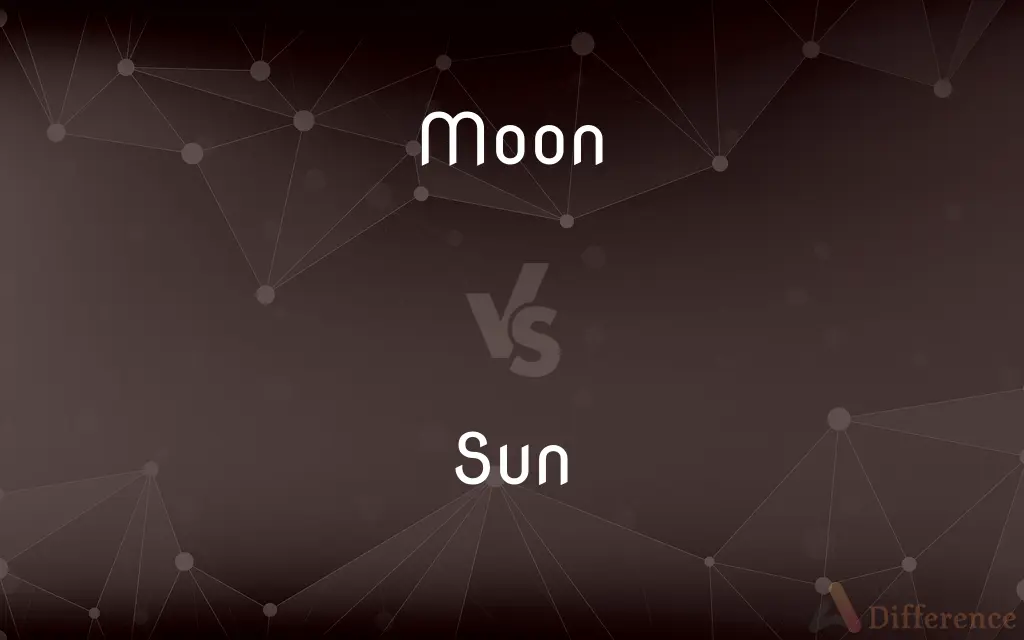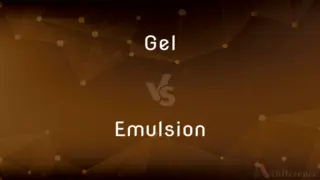Moon vs. Sun — What's the Difference?
By Tayyaba Rehman & Fiza Rafique — Updated on April 14, 2024
The Moon, Earth's only natural satellite, reflects sunlight and influences tides, while the Sun, a star, generates light and heat essential for life on Earth.

Difference Between Moon and Sun
Table of Contents
ADVERTISEMENT
Key Differences
The Moon orbits Earth and is visible primarily due to reflected sunlight, whereas the Sun is at the center of our solar system and emits light through nuclear fusion.
The Moon impacts Earth's tides due to its gravitational pull, while the Sun’s gravity helps keep the solar system in orbit.
The Moon undergoes phases from new moon to full moon as its position relative to Earth and the Sun changes, on the other hand, the Sun remains consistently bright, seen from Earth as a nearly perfect sphere.
The Moon's surface is covered with craters, dust, and rocky mountains, whereas the Sun’s surface includes dynamic features like sunspots, solar flares, and prominences.
The Moon has no atmosphere and no weather conditions, in contrast, the Sun has a hot, dynamic atmosphere that influences space weather.
ADVERTISEMENT
Comparison Chart
Type
Natural satellite
Star
Primary Function
Reflects sunlight, affects tides
Generates light and heat
Composition
Rocky, with regolith surface
Mostly hydrogen and helium
Visibility Phases
New moon to full moon
Always visible as a bright sphere
Impact on Earth
Tidal forces, minor impact on climate
Essential for climate, photosynthesis
Compare with Definitions
Moon
It affects Earth’s tides through its gravitational pull.
High tides are higher when the Moon is full or new.
Sun
The Sun’s gravity holds the solar system together.
Planets orbit the Sun due to its gravitational pull.
Moon
It reflects sunlight, not producing its own light.
The Moon shines brightest during a full moon.
Sun
The Sun is a medium-sized star at the center of our solar system.
The Sun provides the light and heat necessary for life on Earth.
Moon
The Moon is Earth's natural satellite.
The Moon orbits the Earth every 27.3 days.
Sun
The Sun influences Earth's climate and weather.
Solar flares can cause disruptions in Earth's magnetic field.
Moon
The Moon has phases depending on its position relative to Earth and the Sun.
During a new moon, the Moon is between Earth and the Sun.
Sun
It is composed mostly of hydrogen and helium.
Hydrogen in the Sun's core fuses into helium, releasing energy.
Moon
The Moon's surface is covered in craters and dust.
The largest crater on the Moon is the South Pole-Aitken Basin.
Sun
It generates energy through nuclear fusion.
The core of the Sun reaches temperatures over 15 million degrees Celsius.
Moon
The Moon is Earth's only natural satellite. At about one-quarter the diameter of Earth (comparable to the width of Australia), it is the largest natural satellite in the Solar System relative to the size of its planet, the fifth largest satellite in the Solar System overall, and is larger than any known dwarf planet.
Sun
The Sun is the star at the center of the Solar System. It is a nearly perfect sphere of hot plasma, heated to incandescence by nuclear fusion reactions in its core, radiating the energy mainly as visible light, ultraviolet light, and infrared radiation.
Moon
Often Moon The natural satellite of Earth, visible by reflection of sunlight and having a slightly elliptical orbit, approximately 363,100 kilometers (225,600 miles) distant at perigee and 405,700 kilometers (252,100 miles) at apogee. Its mean diameter is 3,475 kilometers (2,159 miles), its mass approximately one eightieth that of Earth, and its average period of revolution around Earth 29 days 12 hours 44 minutes calculated with respect to the sun.
Sun
Often Sun The star around which Earth and other planets orbit. It provides heat and light to Earth. It has a mean distance from Earth of about 150 million kilometers (93 million miles), a diameter of approximately 1,391,000 kilometers (864,000 miles), and a mass about 333,000 times that of Earth.
Moon
A natural satellite revolving around a planet.
Sun
A star that is the center of a planetary system.
Moon
The moon as it appears at a particular time in its cycle of phases
A gibbous moon.
Sun
The radiant energy, especially heat and visible light, emitted by the sun; sunshine.
Moon
A month, especially a lunar month.
Sun
A sunlike object, representation, or design.
Moon
A disk, globe, or crescent resembling the natural satellite of Earth.
Sun
To expose to the sun's rays, as for warming, drying, or tanning.
Moon
Moonlight.
Sun
To expose oneself or itself to the sun.
Moon
Something unreasonable or unattainable
They acted as if we were asking for the moon.
Sun
The star that the Earth revolves around and from which it receives light and warmth.
Moon
(Slang) The bared buttocks.
Sun
(astronomy) A star, especially when seen as the centre of any single solar system.
Moon
To wander about or pass time languidly and aimlessly.
Sun
The light and warmth which is received from the sun; sunshine or sunlight.
Moon
To yearn or pine as if infatuated.
Sun
(figurative) Something like the sun in brightness or splendor.
Moon
(Slang) To expose one's buttocks in public as a prank or disrespectful gesture.
Sun
Sunrise or sunset.
Moon
(Slang) To expose one's buttocks to (others) as a prank or disrespectful gesture
"threatened to moon a passing ... camera crew" (Vanity Fair).
Sun
A revolution of the Earth around the Sun; a year.
Moon
Senseid|en|Q405}} {{alternative case form of Moon.
Sun
A transversing of the sky by the Sun; a day.
Moon
Any natural satellite of a planet.
The stargazer observed the moons of Jupiter for over a year.
That's no moon, you idiot... it's a space station!
Sun
The nineteenth trump/major arcana card of the Tarot.
Moon
(literary) A month, particularly a lunar month.
They stayed with their aunt and uncle for many moons.
Sun
(cartomancy) The thirty-first Lenormand card.
Moon
A representation of the moon, usually as a crescent or as a circle with a face; a crescent-shaped shape, symbol, or object.
The wizard costume was decorated with stars and moons.
Sun
A traditional Japanese unit of length, approximately 30.3 millimetres (1.193 inches).
Moon
A crescent-like outwork in a fortification.
The moons surrounding the city walls were built in the sixteenth century.
Sun
(transitive) To expose to the warmth and radiation of the sun.
Beautiful bodies lying on the beach, sunning their bronzed limbs.
Moon
The eighteenth trump/major arcana card of the Tarot.
Sun
(transitive) To warm or dry in the sunshine.
Moon
(cartomancy) The thirty-second Lenormand card.
Sun
(intransitive) To be exposed to the sun.
Moon
(card games) In hearts, the action of taking all the point cards in one hand.
Sun
To expose the eyes to the sun as part of the Bates method.
Moon
To display one's buttocks to, typically as a jest, insult, or protest.
The hooligans mooned the riot police.
It was ill-advised of Sam to moon the photographer during the shoot.
Sun
See Sunn.
Moon
To gaze at lovingly or in adoration.
Sun
The luminous orb, the light of which constitutes day, and its absence night; the central body round which the earth and planets revolve, by which they are held in their orbits, and from which they receive light and heat. Its mean distance from the earth is about 92,500,000 miles, and its diameter about 860,000.
Moon
(usually followed by over or after) To fuss over something adoringly; to be infatuated with someone.
Sarah mooned over Sam's photograph for months.
You've been mooning after her forever; why not just ask her out?
Sun
Any heavenly body which forms the center of a system of orbs.
Moon
To spend time idly, absent-mindedly.
Sun
The direct light or warmth of the sun; sunshine.
Lambs that did frisk in the sun.
Moon
(transitive) To expose to the rays of the Moon.
Sun
That which resembles the sun, as in splendor or importance; any source of light, warmth, or animation.
For the Lord God is a sun and shield.
I will never consent to put out the sun of sovereignity to posterity.
Moon
(transitive) To adorn with moons or crescents.
Sun
To expose to the sun's rays; to warm or dry in the sun; as, to sun cloth; to sun grain.
Then to sun thyself in open air.
Moon
To rise in price rapidly or suddenly.
It is impractical if a currency moons and plummets often.
Sun
A typical star that is the source of light and heat for the planets in the solar system;
The sun contains 99.85% of the mass in the solar system
Moon
(card games) To shoot the moon.
Sun
The rays of the sun;
The shingles were weathered by the sun and wind
Moon
The celestial orb which revolves round the earth; the satellite of the earth; a secondary planet, whose light, borrowed from the sun, is reflected to the earth, and serves to dispel the darkness of night. The diameter of the moon is 2,160 miles, its mean distance from the earth is 240,000 miles, and its mass is one eightieth that of the earth. See Lunar month, under Month.
The crescent moon, the diadem of night.
Sun
A person considered as a source of warmth or energy or glory etc
Moon
A secondary planet, or satellite, revolving about any member of the solar system; as, the moons of Jupiter or Saturn.
Sun
Any star around which a planetary system evolves
Moon
The time occupied by the moon in making one revolution in her orbit; a month.
Sun
First day of the week; observed as a day of rest and worship by most Christians
Moon
A crescentlike outwork. See Half-moon.
Sun
Expose one's body to the sun
Moon
The deliberately exposed naked buttocks.
Sun
Expose to the rays of the sun or affect by exposure to the sun;
Insolated paper may turn yellow and crumble
These herbs suffer when sunned
Moon
To expose to the rays of the moon.
If they have it to be exceeding white indeed, they seethe it yet once more, after it hath been thus sunned and mooned.
Moon
To expose one's naked buttocks to (a person); - a vulgar sign of contempt or disrespect, sometimes done as a prank.
Moon
To act if moonstruck; to wander or gaze about in an abstracted manner.
Elsley was mooning down the river by himself.
Moon
The natural satellite of the Earth;
The average distance to the moon is 384,400 kilometers
Men first stepped on the moon in 1969
Moon
Any object resembling a moon;
He made a moon lamp that he used as a night light
The clock had a moon that showed various phases
Moon
The period between successive new moons (29.531 days)
Moon
The light of the moon;
Moonlight is the smuggler's enemy
The moon was bright enough to read by
Moon
United States religious leader (born in Korea) who founded the Unification Church in 1954; was found guilty of conspiracy to evade taxes (born in 1920)
Moon
Any natural satellite of a planet;
Jupiter has sixteen moons
Moon
Have dreamlike musings or fantasies while awake;
She looked out the window, daydreaming
Moon
Be idle in a listless or dreamy way
Moon
Expose one's buttocks to;
Moon the audience
Common Curiosities
Can we see the Sun at night?
No, the Sun is below the horizon at night.
Why does the Moon have phases?
The Moon's phases result from its orbit, changing the portion illuminated by the Sun.
How far is the Moon from Earth?
The Moon is about 384,400 km away from Earth.
How does the Moon affect wildlife?
Many species rely on the Moon's phases for breeding and migration.
How does the Sun’s energy reach Earth?
The Sun’s energy travels to Earth as solar radiation, primarily light and heat.
What is a lunar eclipse?
A lunar eclipse occurs when the Earth comes between the Sun and the Moon, casting a shadow on the Moon.
Is the Moon larger than the Sun?
The Moon is much smaller than the Sun but appears large because it is closer to Earth.
What are sunspots?
Sunspots are cooler, darker areas on the Sun's surface.
What is solar wind?
Solar wind is a stream of charged particles released from the Sun’s atmosphere.
How does the Sun affect Earth besides providing light?
The Sun’s gravity influences Earth's orbit and its magnetic field impacts our space weather.
What causes the Moon to shine at night?
The Moon shines by reflecting sunlight.
Does the Moon have its own light?
No, the Moon does not generate light; it only reflects sunlight.
What elements are found on the Moon?
The Moon’s surface is primarily composed of oxygen, silicon, magnesium, iron, calcium, and aluminum.
Can solar activity affect technology on Earth?
Yes, intense solar activity can disrupt satellite communications and power grids.
What is the temperature on the Moon during the day?
Daytime temperatures on the Moon can reach up to 127 degrees Celsius.
Share Your Discovery

Previous Comparison
Gel vs. Emulsion
Next Comparison
Art vs. CraftAuthor Spotlight
Written by
Tayyaba RehmanTayyaba Rehman is a distinguished writer, currently serving as a primary contributor to askdifference.com. As a researcher in semantics and etymology, Tayyaba's passion for the complexity of languages and their distinctions has found a perfect home on the platform. Tayyaba delves into the intricacies of language, distinguishing between commonly confused words and phrases, thereby providing clarity for readers worldwide.
Co-written by
Fiza RafiqueFiza Rafique is a skilled content writer at AskDifference.com, where she meticulously refines and enhances written pieces. Drawing from her vast editorial expertise, Fiza ensures clarity, accuracy, and precision in every article. Passionate about language, she continually seeks to elevate the quality of content for readers worldwide.














































